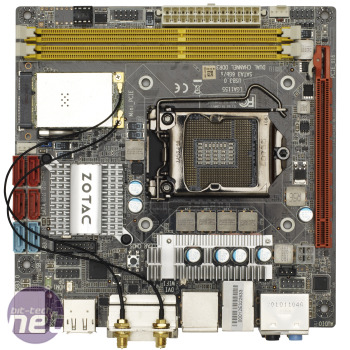Hi mọi người,
Mình sử dụng con Dell zino HD đc gần 2 năm, phải nói là chạy êm nhẹ nhàng, lại nhỏ gọn nên đâm ra yêu thích dòng HTPC. Nay muốn build một HTPC mới để ngoài mục đích HD còn chơi game. Vấn đề CPU (i5/7), RAM, GPU thì thôi không bàn nữa vì cũng dễ chọn, nhưng cái chính ở đây là chơi HTPC mạnh thì phải chọn 1 em main mini-ITX hỗ trợ được đầy đủ (bỏ qua mấy cái Fusion, APU gì đó nhé). Dạo qua một vòng thì thấy nổi trội hiện nay có 2 em:
1) ASUS P8H67 - I Deluxe

Link review con main này
2) Zotac H67 ITX Wifi

LInk review con main này
Mọi người comment sâu hơn về các ưu/nhược điểm 2 cái trên và suggest thêm một các main mini ITX khác (Asrock, MSI ...) ngon hơn (nếu có).
Clip
[video=youtube;KDJ7KhOd1SY]http://www.youtube.com/watch?v=KDJ7KhOd1SY[/video]
FINAL THOUGHTS
Compared to the Zotac H67-ITX, the P8H67-I has a touch higher idle power consumption, but the difference is trivial compared to the >10W advantage the P8H67-I has on load. The UEFI even allows for undervolting which could potentially make the board even more energy efficient. The UEFI is essentially the same as those offered on Asus' microATX/ATX variants, providing a fair degree of customization, at least as much as a H67 chipset board is capable of. Fan control, both in the UEFI and Asus' FanXpert utility offers more versatile options and the fans adhere strictly to the settings entered.
The H67-ITX does have the small edge in features, sporting two more SATA ports, a DisplayPort connector, and a couple of extra accessories, while the P8H67-I can only boast the inclusion of a Bluetooth receiver. However, this doesn't tell the entire story. Both boards offer 802.11n and USB 3.0, but surprisingly the performance of these peripherals were both substantially faster on the Asus board. The included WiFi antennae can also be placed a couple of feet away from the system, which could give it an advantage, particularly in areas that might have difficulty picking up a strong signal.
If you're thinking about building a SFF Sandy Bridge PC, the Asus P8H67-I Deluxe is simply the better motherboard, whether you're interested in energy efficiency, peripheral performance, or usability. A file server is the only type of system where we would recommend the Zotac H67-ITX instead, as its lower idle power consumption and six SATA ports are compelling. The P8H67-I is currently retailing for approximately US$150, about US$10 more than the H67-ITX. As the Asus board is superior in so many ways, we feel it is well worth the extra cost.
Tks&Brs
chanb0.
Mình sử dụng con Dell zino HD đc gần 2 năm, phải nói là chạy êm nhẹ nhàng, lại nhỏ gọn nên đâm ra yêu thích dòng HTPC. Nay muốn build một HTPC mới để ngoài mục đích HD còn chơi game. Vấn đề CPU (i5/7), RAM, GPU thì thôi không bàn nữa vì cũng dễ chọn, nhưng cái chính ở đây là chơi HTPC mạnh thì phải chọn 1 em main mini-ITX hỗ trợ được đầy đủ (bỏ qua mấy cái Fusion, APU gì đó nhé). Dạo qua một vòng thì thấy nổi trội hiện nay có 2 em:
1) ASUS P8H67 - I Deluxe

Link review con main này
2) Zotac H67 ITX Wifi

LInk review con main này
Mọi người comment sâu hơn về các ưu/nhược điểm 2 cái trên và suggest thêm một các main mini ITX khác (Asrock, MSI ...) ngon hơn (nếu có).
Clip
[video=youtube;KDJ7KhOd1SY]http://www.youtube.com/watch?v=KDJ7KhOd1SY[/video]
FINAL THOUGHTS
Compared to the Zotac H67-ITX, the P8H67-I has a touch higher idle power consumption, but the difference is trivial compared to the >10W advantage the P8H67-I has on load. The UEFI even allows for undervolting which could potentially make the board even more energy efficient. The UEFI is essentially the same as those offered on Asus' microATX/ATX variants, providing a fair degree of customization, at least as much as a H67 chipset board is capable of. Fan control, both in the UEFI and Asus' FanXpert utility offers more versatile options and the fans adhere strictly to the settings entered.
The H67-ITX does have the small edge in features, sporting two more SATA ports, a DisplayPort connector, and a couple of extra accessories, while the P8H67-I can only boast the inclusion of a Bluetooth receiver. However, this doesn't tell the entire story. Both boards offer 802.11n and USB 3.0, but surprisingly the performance of these peripherals were both substantially faster on the Asus board. The included WiFi antennae can also be placed a couple of feet away from the system, which could give it an advantage, particularly in areas that might have difficulty picking up a strong signal.
If you're thinking about building a SFF Sandy Bridge PC, the Asus P8H67-I Deluxe is simply the better motherboard, whether you're interested in energy efficiency, peripheral performance, or usability. A file server is the only type of system where we would recommend the Zotac H67-ITX instead, as its lower idle power consumption and six SATA ports are compelling. The P8H67-I is currently retailing for approximately US$150, about US$10 more than the H67-ITX. As the Asus board is superior in so many ways, we feel it is well worth the extra cost.
Tks&Brs
chanb0.
Chỉnh sửa lần cuối:

